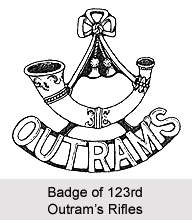 The 23rd Regiment of Bombay Native Infantry was a former British Indian infantry regiment that was raised in the year 1820 and remained in existence till 1922. The battalion operated as a division of the Bombay Native Infantry. It served under the Bombay Army, which was the official armed force of the Bombay Presidency and was one of the main Presidency Armies in British India. It was also as a part of the Bombay Command. The regiment was managed by the East India Company until the Sepoy Mutiny of 1857. But after the authorization of the Government of India Act 1858, the native infantry unit was controlled by the British Empire in India. Later in 1903, the army battalion of the 23rd Regiment of Bombay Native Infantry was included as a part of the United British Indian Army. The army unit was also known as the 123rd Outram`s Rifles regiment.
The 23rd Regiment of Bombay Native Infantry was a former British Indian infantry regiment that was raised in the year 1820 and remained in existence till 1922. The battalion operated as a division of the Bombay Native Infantry. It served under the Bombay Army, which was the official armed force of the Bombay Presidency and was one of the main Presidency Armies in British India. It was also as a part of the Bombay Command. The regiment was managed by the East India Company until the Sepoy Mutiny of 1857. But after the authorization of the Government of India Act 1858, the native infantry unit was controlled by the British Empire in India. Later in 1903, the army battalion of the 23rd Regiment of Bombay Native Infantry was included as a part of the United British Indian Army. The army unit was also known as the 123rd Outram`s Rifles regiment.
History of 23rd Regiment of Bombay Native Infantry
The 23rd Regiment of Bombay Native Infantry was raised by the Honourable British East India Company as part of the 12th Regiment of Bombay Native Infantry in the year 1820. The unit was initially designated as the 1st Battalion of the regiment; but later in 1824 it was developed as a separate regiment and was named as the 23rd Regiment of Bombay Native Infantry. The regiment was subsequently renamed as the 23rd Regiment of Bombay Native Light Infantry in the year 1841.
Military Operations of 23rd Regiment of Bombay Native Infantry
On 5 November 1817, the regiment took part in the Battle of Khadki during the Third Anglo Maratha War. It participated in the First Anglo Afghan War in the year 1839 and was later in 1841 it was re-designated as the 23rd Regiment of Bombay Native Light Infantry. The troops also fought in the First Anglo Afghan War in 1839, as well as the Anglo Persian War from 1856 to 1857. During the upheaval of the Sepoy Mutiny in 1857, the troops of the unit maintained their loyalty towards the British authorities, like almost all other regiments of the Bombay Army. The 123rd Outram`s Rifles then fought in the Second Anglo Afghan War in 1879 and the Third Anglo Burmese War from the year 1885 to 1887.
In 1889, the unit was designated as a rifle regiment and was named as the 23rd Regiment (2nd Rifle Regiment) of Bombay Infantry. The troops were stationed at Aden in the year 1903. In 1901, it was again renamed as the 23rd Bombay Rifles. The regiment was awarded with the battle honours for Burma 1885- 1887; Afghanistan 1879- 1880; Persia; and Kirkee. After the reorganization of the British Indian Army administered by Lord Kitchener in 1903, it was titled as the 123rd Outram`s Rifles.
The infantry regiment actively served during the First World War and was stationed in the Middle East. Later some of the troops were posted on the Western Front and were attached to other battalions. The unit also took part in the Third Battle of Gaza in 1917 and the Megiddo Campaign in 1918.
Development of 23rd Regiment of Bombay Native Infantry
After World War I, the British Indian Government re-numbered and re-grouped the regiments in 1922. The various single infantry regiments were amalgamated to raise larger multi battalion infantry units of four to six battalions. Thus, the regiment was merged with 5 other units, including the 125th Napier`s Rifles in order to develop the 6th Rajputana Rifles. It became the 4th Battalion (Outram`s).
Designations of 23rd Regiment of Bombay Native Infantry
The 23rd Regiment of Bombay Native Infantry of the British Indian Army occupied a number of designations through out its service. These are mentioned below-
* 1st Battalion 12th Regiment of Bombay Native Infantry in 1820
* 23rd Regiment of Bombay Native Infantry in 1824
* 23rd Regiment of Bombay Native Light Infantry in 1841
* 23rd Regiment (2nd Rifle Regiment) of Bombay Infantry in 1889
* 123rd Outram`s Rifles in 1903
* 6th Rajputana Rifles in 1922
* 4th Battalion (Outram`s)



















